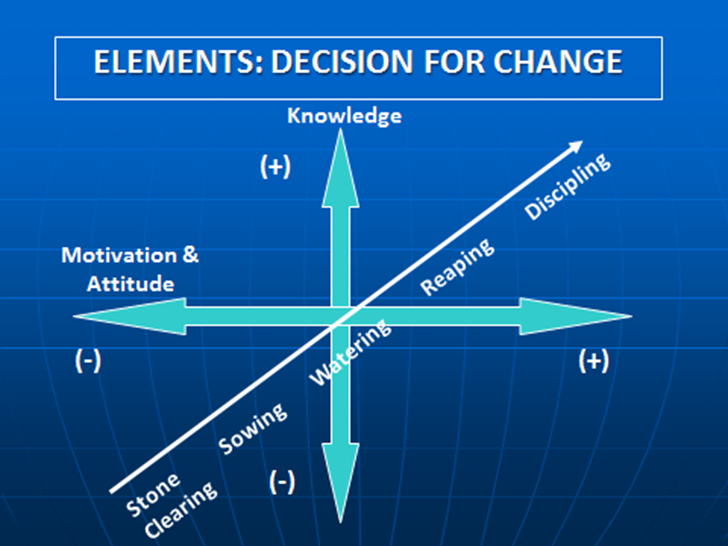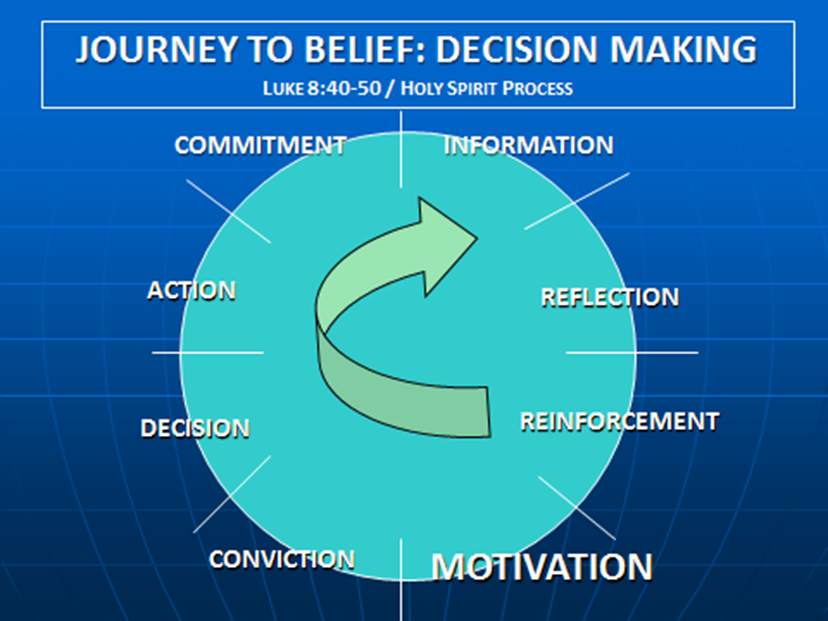As consider our approach or strategies for evangelism, whether inter-personal, social media, or other forms of communications understanding both the key elements and the process of decision-making can greatly strengthen our initiatives. These very simple charts and associated Biblical references illustrate the timeless character of these key points.
The Elements of Decision-Making For Change

Biblical Framework
Illustrations from two ends of the knowledge/motivation/attitude spectrum serve to make the point.
John 9:13-34
The ruling religious leaders were high in knowledge but de-motivated to consider a new message which threatened their status. (See also John 7:25-52, John 19:1-16.)
Mark 1:40-45, Luke 23:39-43
The ragged, broken, socially ostracized leper and one of the criminals on the cross would appear to have minimal knowledge (compared, say, to the Pharisees/Sadducees) but sufficient knowledge combined with high motivation to create an openness to Jesus’ transforming power.
John 3:1-21, 7:50-53, 19:38-42 and Luke 8:40-56
Nicodemus and Jairus are classic illustrations of well-defined attitudes change based on changing knowledge and/or circumstances which affect motivation.
- Nicodemus’ three appearances in John’s gospel clearly chronicle his journey from motivated doubt, through tentative peer advocacy, to open declaration of his commitment.
- Jairus, a synagogue leader in jesus’ adopted home town was clearly a part of the Jewish religious establishment. However, with a dying daughter and all likely remedies exhausted, his ‘costs/benefits analysis’ leads him to appeal to Jesus for help.
Strategic Considerations
- What might be some of the implications of the diagram and scriptural references/stories for our evangelism and/or church planting strategies?
- Have we done an analysis of our audience using the categories and stages of the spiritual journey implied by the Scriptures?
- If our media evangelism strategies consciously took these issues into account, how might it affect the specifics of our approach to use of people and/or media?
- Have we sought to develop specific approaches, content, strategies, and tactics that align with where they are on the spiritual journey?
The Process of Decision-Making for Change
Biblical content and sociological research (truth is always God’s truth) make clear that decision-making for change is always a process. This, of course, relates to Section 1, Evangelism: A Process Or Event? The key elements are:
- Sufficient knowledge
- Reflection on or consideration of the knowledge (information)
- Reinforcement/expansion of the knowledge
Note: Classically these first three steps are an on-going loop which moves on to the next stage only when there is sufficient motivation. In consideration/acceptance of Jesus, this loop may appear to be comparatively short, as in the case of children. Or, lengthy, as in the case of those who make a decision for Christ later in life.
- Sufficient motivation for change
- Conviction – belief that the change will produce a desired outcome that outweighs any potential negatives. The well-known “cost/benefits analysis” (consider the Rich Young Ruler).
- Decision – confirmation of the conviction that motivates the critical next step.
- Action – Turning thought and conviction into reality.
- Recommitment – Affirmation of previous decision.
Consider the relationship of the diagram below and that found in Section 3. This suggests that for spiritual movement of an individual upward along the diagonal line in diagram 3, from antagonism or indifference to belief, the process shown in the diagram below must occur.

Biblical Framework
Consider two of the cases previously mentioned; Nicodemus and Jairus.
John 3:1-21, 7:50-53, 19:38-42
Nicodemus appears in John 3 bringing parallel sets of information: the traditional information rooted in his Jewish religious leader’s training; and, the new information rising out of his own observation of Jesus life & ministry and, likely, the rising level of discussion about Jesus both among both his peers and the general public with whom he mixed. We see the distinct passage of Nicodemus’ process along this continuum of conviction and commitment as he: first, comes to Jesus by night – afraid of his peers; then, advocating on Jesus behalf with his peers and suffering their ridicule; finally, his public affirmation as he joins with Joseph of Arimathea to take Jesus body from the cross and place it in the tomb.
Luke 8:40-56
Jairus has a 12 year old daughter who is dying. Desperate he falls to his knees in front of Jesus and begs for help. In character, Jesus responds and the girls is healed – in fact, brought back from the dead! The context is as follows. Jairus was a religious leader in Jesus’ adopted home town of Capernaum. His connections with the religious establishment in Jerusalem would have been evident. As a leader of the synagogue where Jesus’ regularly taught (Mark 1), Jairus had an up-close view of the spectacular trajectory of Jesus’ ministry. Jairus also knew Jesus’ disciples since we know this was Peter’s home town. His call on Jesus occured well into Jesus’ ministry – possibly even in the final few months. Based on the state of the girl’s condition when Jairus sought out Jesus, he had tried every other possible option before, in desperation, turning to Jesus, at 11:59, as the court of last resort. Jairus represents a classic case history in which, in a comparatively short period of time, we can clearly see the progression of the elements outlined in the diagram above. He had a rich data base of traditional Jewish religious assumptions. He had an in-depth exposure to Jesus’ ministry. Despite the compelling evidence which Jairus regularly saw, the personal ‘risk/reward’ balance was insufficient to motivate turning his back on his religious peers and threaten his social standing. But even compelling information was insufficient to motivate his change. Only when his perceived need became sufficiently acute was he prepared to, in front of his own ‘parishioners,’ in total humility (remember, this is an eastern culture) fall begging to the ground in front of Jesus in the middle of the town, in broad daylight. The potential of personal rewards overwhelmed the potential personal/professional risks.
Strategic Considerations
The audiences of Palestine in Jesus’ day and audiences like the Muslim world of today provide interesting basis for comparison.
- How do we plan effective evangelism strategies when we know that, at any given moment, members of the wider ‘audience’ are at different stages in the decision-making process?
- Personal, one to one relationships may or may not give authentic insight regarding the state of an individual’s heart or spiritual journey. However, what of the thousands or millions who are not in an authentic personal relationship with a Christian evangelist? For instance, those exposed daily to witness via radio, TV, social media, internet, other forms of communication – or, the power of God’s general revelation and/or other forms of God’s loving communication? Genuinely committed to the most effective evangelism strategies, how do we take into account and/or seek to link these forms of witness with personal, one to one witness for greatest effectiveness? (Remember, Jairus input about Jesus was from more than personal observation. He had input from both Jesus’ friends and enemies, in Capernaum’s cafes, markets, in the homes of friends, and on the occasional trip up to Jerusalem, Jairus received a constant stream of varied input from other sources.)